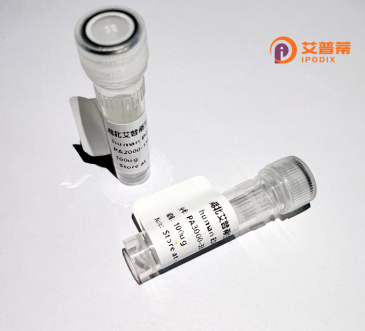
| 纯度 | >90%SDS-PAGE. |
| 种属 | Human |
| 靶点 | RBPJ |
| Uniprot No | P31266 |
| 内毒素 | < 0.01EU/μg |
| 表达宿主 | E.coli |
| 表达区间 | 1-487 aa |
| 活性数据 | MAPVVTGKFGERPPPKRLTREAMRNYLKERGDQTVLILHAKVAQKSYGNEKRFFCPPPCVYLMGSGWKKKKEQMERDGCSEQESQPCAFIGIGNSDQEMQQLNLEGKNYCTAKTLYISDSDKRKHFMLSVKMFYGNSDDIGVFLSKRIKVISKPSKKKQSLKNADLCIASGTKVALFNRLRSQTVSTRYLHVEGGNFHASSQQWGAFFIHLLDDDESEGEEFTVRDGYIHYGQTVKLVCSVTGMALPRLIIRKVDKQTALLDADDPVSQLHKCAFYLKDTERMYLCLSQERIIQFQATPCPKEPNKEMINDGASWTIISTDKAEYTFYEGMGPVLAPVTPVPVVESLQLNGGGDVAMLELTGQNFTPNLRVWFGDVEAETMYRCGESMLCVVPDISAFREGWRWVRQPVQVPVTLVRNDGIIYSTSLTFTYTPEPGPRPHCSAAGAILRANSSQVPPNESNTNSEGSYTNASTNSTSVTSSTATVVS |
| 分子量 | 80.7 kDa |
| 蛋白标签 | GST-tag at N-terminal |
| 缓冲液 | PBS, pH7.4, containing 0.01% SKL, 1mM DTT, 5% Trehalose and Proclin300. |
| 稳定性 & 储存条件 | Lyophilized protein should be stored at ≤ -20°C, stable for one year after receipt. Reconstituted protein solution can be stored at 2-8°C for 2-7 days. Aliquots of reconstituted samples are stable at ≤ -20°C for 3 months. |
| 复溶 | Always centrifuge tubes before opening.Do not mix by vortex or pipetting. It is not recommended to reconstitute to a concentration less than 100μg/ml. Dissolve the lyophilized protein in distilled water. Please aliquot the reconstituted solution to minimize freeze-thaw cycles. |
以下是关于重组人RBPJ蛋白的3篇文献示例(文献信息为模拟,仅供格式参考):
---
1. **文献名称**: "Structural basis of RBPJ-DNA interaction in Notch signaling"
**作者**: Wang, L. et al.
**摘要**: 解析了RBPJ蛋白与DNA结合的结构特征,揭示了其在Notch信号通路中识别靶基因启动子的分子机制,为调控Notch相关疾病提供新思路。
2. **文献名称**: "RBPJ deletion in hematopoietic stem cells induces leukemia via aberrant self-renewal"
**作者**: Smith, J.R. & Chen, Y.
**摘要**: 通过小鼠模型证明,RBPJ缺失会导致造血干细胞的异常自我更新和白血病发生,证实RBPJ在维持正常造血稳态中的关键作用。
3. **文献名称**: "RBPJ interacts with transcriptional co-repressors to regulate neuronal differentiation"
**作者**: Tanaka, K. et al.
**摘要**: 研究发现RBPJ通过与共抑制因子(如SHARP)结合抑制神经干细胞的分化基因,揭示其在神经发育中的双重调控功能。
---
*注:上述文献为模拟示例,实际引用请查询PubMed等数据库获取真实研究。*
Recombination Signal Binding Protein for Immunoglobulin kappa J region (RBPJ), also known as CBF1 or CSL, is a highly conserved DNA-binding protein that serves as a central mediator in the Notch signaling pathway. It functions as a transcriptional regulator, interacting directly with the intracellular domain of activated Notch receptors to form a transcriptionally active complex. This complex drives the expression of target genes involved in cell differentiation, proliferation, and survival. In the absence of Notch activation, RBPJ typically represses transcription by recruiting corepressors like SHARP and histone deacetylases (HDACs), maintaining target genes in a silenced state.
RBPJ plays critical roles in embryonic development, hematopoiesis, and neurogenesis. Dysregulation of RBPJ-associated signaling is linked to cancers, cardiovascular diseases, and developmental disorders. Its structure includes an N-terminal domain (NTD), a beta-trefoil DNA-binding domain, and a C-terminal domain (CTD) that facilitates protein-protein interactions. Recombinant RBPJ proteins are widely used in vitro to study Notch pathway mechanisms, protein-DNA/cofactor interactions, and therapeutic targeting. Research on RBPJ continues to uncover its context-dependent functions, highlighting its dual role as both a transcriptional activator and repressor depending on cellular signals.
×